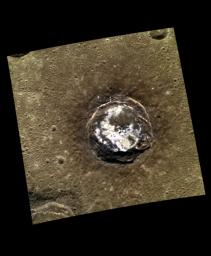Sander’s Shining!
Caption:
Today's color image highlights the bright hollows on the floor and peaks of
Sander crater
, named after the German photographer August Sander. The process responsible for these
bright, shallow formations
is still unknown, but it is possible that volatile sublimation is etching away at the surface.
This image was acquired as a targeted high-resolution 11-color image set. Acquiring 11-color targets is a new campaign that began in March 2013 and that utilizes all of the WAC's 11 narrow-band color filters. Because of the large data volume involved, only features of special scientific interest are targeted for imaging in all 11 colors.
Date acquired:
June 06, 2013
Image Mission Elapsed Time (MET):
12802777, 12802773, 12802771
Image ID:
4204118, 4204116, 4204115
Instrument:
Wide Angle Camera (WAC) of the Mercury Dual Imaging System (MDIS)
WAC filters:
9, 7, 6 (996, 748, 433 nanometers) in red, green, and blue
Center Latitude:
42.53°
Center Longitude:
154.2° E
Resolution:
265 meters/pixel
Scale:
Crater diameter is about 51 km (31.7 miles)
Incidence Angle:
42.9°
Emission Angle:
26.5°
Phase Angle:
69.4°
Background Info:
The MESSENGER spacecraft is the first ever to orbit the planet Mercury, and the spacecraft's
seven scientific instruments and radio science investigation
are unraveling the history and evolution of the Solar System's innermost planet. MESSENGER acquired over 150,000 images and extensive other data sets. MESSENGER is capable of continuing orbital operations until early 2015.
For information regarding the use of images, see the MESSENGER
image use policy
.
Cataloging Keywords:
| Name |
Value |
Additional Values |
| Target |
Mercury |
|
| System |
|
|
| Target Type |
Planet |
|
| Mission |
MESSENGER |
|
| Instrument Host |
MESSENGER |
|
| Host Type |
Orbiter |
|
| Instrument |
Mercury Dual Imaging System (MDIS) |
|
| Detector |
Wide Angle Camera (WAC) |
|
| Extra Keywords |
Color, Crater, Radio |
| Acquisition Date |
|
| Release Date |
2013-07-29 |
| Date in Caption |
2013-06-06 |
|
| Image Credit |
NASA/Johns Hopkins University Applied Physics Laboratory/Carnegie Institution of Washington |
| Source |
photojournal.jpl.nasa.gov/catalog/PIA17395 |
| Identifier |
PIA17395 |

 Planetary Data System
Planetary Data System
